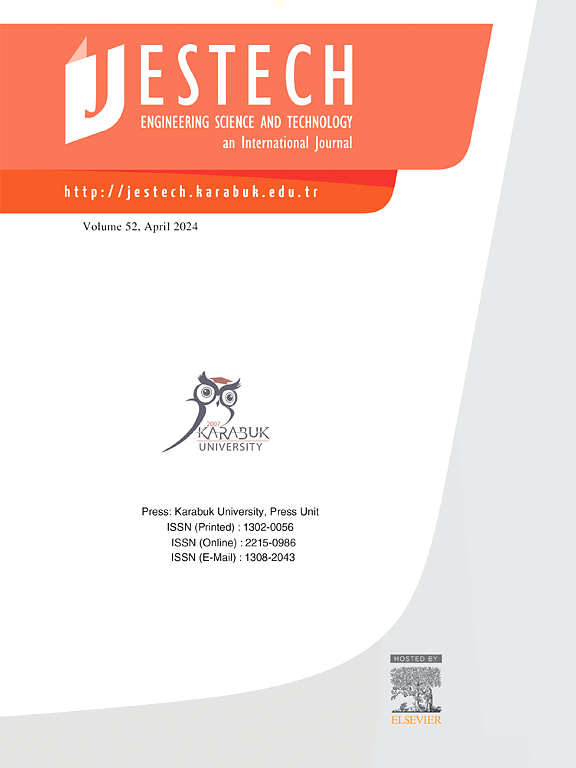Development of bi-directional switched-capacitor DC-DC converter for EV powertrain application
IF 5.4
2区 工程技术
Q1 ENGINEERING, MULTIDISCIPLINARY
Engineering Science and Technology-An International Journal-Jestech
Pub Date : 2025-03-13
DOI:10.1016/j.jestch.2025.102016
引用次数: 0
Abstract
The research presents a novel Bidirectional Switched Capacitor DC-DC (BSCD) Converter and demonstrates its application in integrating a battery with an electric vehicle’s (EV) traction motor. During discharging, the motor is powered by the battery through the converter, and during charging, the traction motor functions as a generator, returning the recovered energy to the battery via the converter. The recommended converter employs a two-duty cycle operation to enhance voltage gain while minimizing circuit components. It utilizes a switched capacitor (SC) cell, enhancing the voltage transfer ratio by operating capacitors CS1 and CS2 in parallel or series. The work includes analysis of the converter’s steady state, mathematical approach, state-space modelling, stability, and efficiency. The proposed converter achieves an efficiency of 90.66 % in charging mode and 96.6 % in discharging mode, with a Gain Margin of 54.4 dB and Phase Margin of 8.09°, indicating stability. Comparative evaluations with existing BDCs are also provided. The implementation of a closed-loop simulation using MATLAB/Simulink and dSpace software validates the performance of the suggested converter-based drive. Furthermore, an experimental investigation of a 200 W, 30 V/430 V configuration confirms the converter’s practical viability.
用于电动汽车动力总成的双向开关电容DC-DC变换器的研制
提出了一种新型的双向开关电容DC-DC (BSCD)变换器,并演示了其在电池与电动汽车牵引电机集成中的应用。在放电时,电机通过变流器由电池供电,在充电时,牵引电机作为发电机,通过变流器将回收的能量返回给电池。推荐的转换器采用双占空比操作,以提高电压增益,同时最大限度地减少电路元件。它利用一个开关电容器(SC)单元,通过并联或串联操作电容器CS1和CS2来提高电压传递比。工作包括分析转换器的稳态、数学方法、状态空间建模、稳定性和效率。该变换器在充电模式和放电模式下的效率分别为90.66%和96.6%,增益裕度为54.4 dB,相位裕度为8.09°,具有良好的稳定性。还提供了与现有bdc的比较评价。利用MATLAB/Simulink和dSpace软件进行闭环仿真,验证了所建议的基于变换器的驱动器的性能。此外,对200w, 30v / 430v配置的实验研究证实了该转换器的实际可行性。
本文章由计算机程序翻译,如有差异,请以英文原文为准。
求助全文
约1分钟内获得全文
求助全文
来源期刊

Engineering Science and Technology-An International Journal-Jestech
Materials Science-Electronic, Optical and Magnetic Materials
CiteScore
11.20
自引率
3.50%
发文量
153
审稿时长
22 days
期刊介绍:
Engineering Science and Technology, an International Journal (JESTECH) (formerly Technology), a peer-reviewed quarterly engineering journal, publishes both theoretical and experimental high quality papers of permanent interest, not previously published in journals, in the field of engineering and applied science which aims to promote the theory and practice of technology and engineering. In addition to peer-reviewed original research papers, the Editorial Board welcomes original research reports, state-of-the-art reviews and communications in the broadly defined field of engineering science and technology.
The scope of JESTECH includes a wide spectrum of subjects including:
-Electrical/Electronics and Computer Engineering (Biomedical Engineering and Instrumentation; Coding, Cryptography, and Information Protection; Communications, Networks, Mobile Computing and Distributed Systems; Compilers and Operating Systems; Computer Architecture, Parallel Processing, and Dependability; Computer Vision and Robotics; Control Theory; Electromagnetic Waves, Microwave Techniques and Antennas; Embedded Systems; Integrated Circuits, VLSI Design, Testing, and CAD; Microelectromechanical Systems; Microelectronics, and Electronic Devices and Circuits; Power, Energy and Energy Conversion Systems; Signal, Image, and Speech Processing)
-Mechanical and Civil Engineering (Automotive Technologies; Biomechanics; Construction Materials; Design and Manufacturing; Dynamics and Control; Energy Generation, Utilization, Conversion, and Storage; Fluid Mechanics and Hydraulics; Heat and Mass Transfer; Micro-Nano Sciences; Renewable and Sustainable Energy Technologies; Robotics and Mechatronics; Solid Mechanics and Structure; Thermal Sciences)
-Metallurgical and Materials Engineering (Advanced Materials Science; Biomaterials; Ceramic and Inorgnanic Materials; Electronic-Magnetic Materials; Energy and Environment; Materials Characterizastion; Metallurgy; Polymers and Nanocomposites)
 求助内容:
求助内容: 应助结果提醒方式:
应助结果提醒方式:


